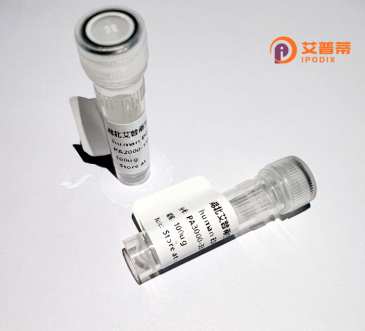
| 纯度 | >90%SDS-PAGE. |
| 种属 | Human |
| 靶点 | PACRG |
| Uniprot No | Q96M98 |
| 内毒素 | < 0.01EU/μg |
| 表达宿主 | E.coli |
| 表达区间 | 1-257 aa |
| 活性数据 | MVAEKETLSLNKCPDKMPKRTKLLAQQPLPVHQPHSLVSEGFTVKAMMKNSVVRGPPAAG AFKERPTKPTAFRKFYERGDFPIALEHDSKGNKIAWKVEIEKLDYHHYLPLFFDGLCEMT FPYEFFARQGIHDMLEHGGNKILPVLPQLIIPIKNALNLRNRQVICVTLKVLQHLVVSAE MVGKALVPYYRQILPVLNIFKNMNVNSGDGIDYSQQKRENIGDLIQETLEAFERYGGENA FINIKYVVPTYESCLLN |
| 分子量 | 33.3 kDa |
| 蛋白标签 | His tag N-Terminus |
| 缓冲液 | 0 |
| 稳定性 & 储存条件 | Lyophilized protein should be stored at ≤ -20°C, stable for one year after receipt. Reconstituted protein solution can be stored at 2-8°C for 2-7 days. Aliquots of reconstituted samples are stable at ≤ -20°C for 3 months. |
| 复溶 | Always centrifuge tubes before opening.Do not mix by vortex or pipetting. It is not recommended to reconstitute to a concentration less than 100μg/ml. Dissolve the lyophilized protein in distilled water. Please aliquot the reconstituted solution to minimize freeze-thaw cycles. |
以下是关于重组人PACRG蛋白的3篇文献概览:
1. **文献名称**:*Parkin Co-regulated Gene (PACRG) is a regulator of ciliogenesis via its interaction with α-tubulin*
**作者**:Ludington AJ 等 (2013)
**摘要**:该研究通过衣藻模型揭示PACRG与α-微管蛋白的相互作用,证明其在纤毛/鞭毛组装中的关键作用,PACRG缺失导致轴丝微管结构异常。
2. **文献名称**:*PACRG regulates TNFα-induced apoptosis via modulating NF-κB signaling pathway in human glioma cells*
**作者**:Chen Y 等 (2016)
**摘要**:研究PACRG在胶质瘤细胞凋亡中的机制,发现其通过抑制NF-κB通路增强TNFα诱导的凋亡,提示PACRG作为肿瘤治疗靶点的潜力。
3. **文献名称**:*The Parkinson’s disease-linked gene PACRG is required for ciliary assembly in Chlamydomonas reinhardtii*
**作者**:Dexter PM 等 (2012)
**摘要**:利用重组蛋白技术,发现衣藻PACRG同源物在纤毛形成中与微管结合,并参与调控鞭毛内运输(IFT)过程,关联帕金森病的纤毛功能障碍假说。
这些研究涵盖了PACRG的结构功能、疾病机制及细胞生物学作用,为理解其在生理与病理中的角色提供了依据。
**Background of Recombinant Human PACRG Protein**
The Parkin Co-regulated Gene (PACRG) protein, encoded by the *PACRG* gene, is a conserved eukaryotic protein implicated in diverse cellular processes. Initially identified as a co-regulated partner of Parkin (*PRKN*), a gene linked to autosomal recessive Parkinson’s disease, PACRG shares bidirectional promoter regions with Parkin but exhibits distinct expression patterns and functions. Structurally, PACRG contains coiled-coil domains, suggesting roles in protein-protein interactions.
Recombinant human PACRG protein, produced via *in vitro* expression systems (e.g., *E. coli* or mammalian cells), enables detailed study of its molecular mechanisms. While endogenous PACRG is ubiquitously expressed, its precise biological functions remain partially characterized. Research highlights its involvement in pathways such as ciliogenesis, autophagy, and immune regulation. Notably, PACRG interacts with proteins like tubulin and Playl, influencing microtubule dynamics and spermatogenesis. Dysregulation of PACRG is associated with pathologies including neurodegenerative disorders, ciliopathies, and infectious diseases like leprosy, where its polymorphisms correlate with susceptibility.
Studies using recombinant PACRG aim to elucidate its role in cellular homeostasis and disease, offering potential therapeutic insights. Its interaction with Parkin further links it to ubiquitin-proteasome system regulation, though its standalone contributions to neurodegeneration require deeper exploration. Current research leverages recombinant PACRG to dissect its structural motifs, post-translational modifications, and binding partners, advancing its application in biomedical studies.
×